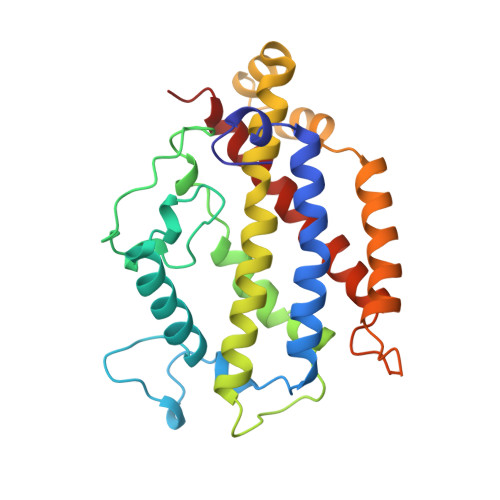Mechanisms of catalysis and allosteric regulation of yeast chorismate mutase from crystal structures.
Strater, N., Schnappauf, G., Braus, G., Lipscomb, W.N.(1997) Structure 5: 1437-1452
- PubMed: 9384560
- DOI: https://doi.org/10.1016/s0969-2126(97)00294-3
- Primary Citation of Related Structures:
3CSM, 4CSM, 5CSM - PubMed Abstract:
Chorismate mutase (CM) catalyzes the Claisen rearrangement of chorismate to prephenate, notably the only known enzymatically catalyzed pericyclic reaction in primary metabolism. Structures of the enzyme in complex with an endo-oxabicyclic transition state analogue inhibitor, previously determined for Bacillus subtilis and Escherichia coli CM, provide structural insight into the enzyme mechanism. In contrast to these bacterial CMs, yeast CM is allosterically regulated in two ways: activation by tryptophan and inhibition by tyrosine. Yeast CM exists in two allosteric states, R (active) and t (inactive). We have determined crystal structures of wild-type yeast CM cocrystallized with tryptophan and an endo-oxabicyclic transition state analogue inhibitor, of wild-type yeast CM co-crystallized with tyrosine and the endo-oxabicyclic transition state analogue inhibitor and of the Thr226-->Ser mutant of yeast CM in complex with tryptophan. Binding of the transition state analogue inhibitor to CM keeps the enzyme in a 'super R' state, even if the inhibitory effector tyrosine is bound to the regulatory site. The endo-oxabicyclic inhibitor binds to yeast CM in a similar way as it does to the distantly related CM from E. coli. The inhibitor-binding mode supports a mechanism by which polar sidechains of the enzyme bind the substrate in the pseudo-diaxial conformation, which is required for catalytic turnover. A lysine and a protonated glutamate sidechain have a critical role in the stabilization of the transition state of the pericyclic reaction. The allosteric transition from T-->R state is accompanied by a 15 degrees rotation of one of the two subunits relative to the other (where 0 degrees rotation defines the T state). This rotation causes conformational changes at the dimer interface which are transmitted to the active site. An allosteric pathway is proposed to include residues Phe28, Asp24 and Glu23, which move toward the activesite cavity in the T state. In the presence of the transition-state analogue a super R state is formed, which is characterised by a 22 degrees rotation of one subunit relative to the other.
Organizational Affiliation:
Department of Chemistry and Chemical Biology, Harvard University, 12 Oxford Street, Cambridge, MA 02138, USA.
















